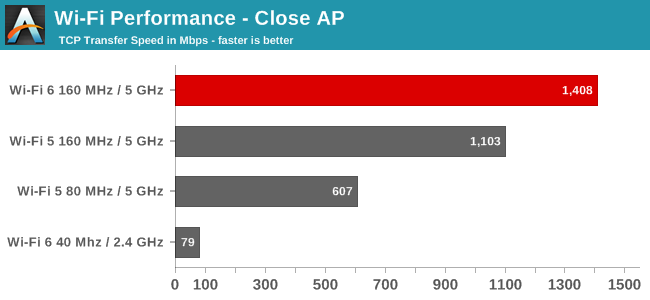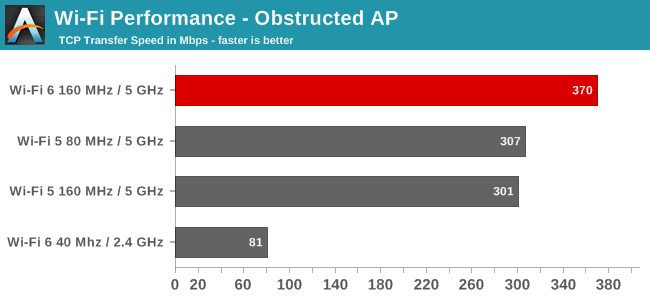AT 101: Wi-Fi 6 And Why You Want It
by Brett Howse on February 12, 2020 8:00 AM ESTPerformance
In order to achieve maximum performance, the latest Wi-Fi 6 standard leverages 1024-level QAM, but depending on the signal strength and quality it will scale down as needed, so to achieve the best performance very high signal to noise ratios are going to be required. Since 5 GHz is attenuated dramatically when it has to go through walls, if you need maximum Wi-Fi performance be aware that you are going to want your wireless router as close to the end device as possible. Luckily that is not an issue in our case, since the router is in the same room when testing for maximum performance, but we’ll also evaluate it in less than ideal scenarios as well.
Wi-Fi 5 vs Wi-Fi 6 – Close AP
First up we’ll test the TCP performance when the Access Point is in the same room as the client.

The performance advantages of Wi-Fi 6 are clear. With the access point in the same room, the SNR is very good and the new 802.11ax standard can really shine. With 1024 QAM and 160 MHz channels, the performance is over twice as fast as the outgoing Wi-Fi 5 with 256 QAM and 80 MHz channels. It is very impressive to see a typical 2x2:2 connection well over the Gigabit barrier, and even though the AX200 network card is the first generation, Intel has already done a fantastic job tuning it. The theoretical maximum transfer rate with 160 MHz channels and 1024 QAM is around 1200 Mbps per connection, so a 2x2 can in theory hit around 2.4 Gbps, meaning there's still room for improvement. Since 802.11ax also can be used on the 2.4 GHz frequency, unlike 802.11ac, the same test was also done on 2.4 GHz, and the results were disappointing. 2.4 GHz can still offer 40 MHz channels, but it doesn’t seem like the AX200 could take advantage of any of that. For reference, the wireless adapter in the laptop was reporting -21 dBm, which is a strong signal, which makes sense since the AP is almost right next to the laptop.
Wi-Fi 5 vs Wi-Fi 6 – Reduced Signal
Moving the laptop further away, and adding several walls and doors in the way to attenuate the signal, the same scenarios were again tested.

With some walls in the way, 5 GHz gets attenuated quite dramatically, and the SNR in the second location was -78 dBm. With such a low signal, the Wi-Fi 6 connection wasn’t able to take advantage of the 1024-level QAM and would have had to drop down to a much lower set, reducing the number of bits per tone, and even though the total channel bandwidth was still 160 MHz, it was only marginally faster on 802.11ax than 802.11ac 80 MHz. 2.4 GHz is not as impacted by walls, and as such was able to maintain the same transfer rate, even though it was still quite a bit slower.
So the results are clear. Wi-Fi 6 can offer a significantly higher level of throughput than Wi-Fi 5, but in order to do so, it needs a strong signal. The Wi-Fi 6 still outperformed the Wi-Fi 5 in the second test with an attenuated signal, but the performance gain was minimal. 2.4 GHz still offers the best signal strength, and therefore would be able to connect further away, and through more obstacles, but doesn’t offer anywhere near the performance of the 5 GHz range. It will be interesting to see the Wi-Fi 6E devices with 6 GHz support when they launch. It will open up Wi-Fi to a wider set of frequency choices, but will offer even less range.










149 Comments
View All Comments
Holliday75 - Wednesday, February 12, 2020 - link
This is my main contention with ever using WiFi on a desktop. I game. Latency and connection stability is everything.Stochastic - Wednesday, February 12, 2020 - link
Yeah, that would be nice. These days I care about latency/jitter a lot more than raw bandwidth.willis936 - Wednesday, February 12, 2020 - link
Name checks out.On this topic: the link is only as stable as the channel. Twisted pair running at 250 MHz won't even feel your microwave turning on. On 2.4 GHz it will turn your SNR to shit. And at 5 GHz someone walking near your WAP will cause issues. Consumer ethernet might be slower (for all that it matters at 1 Gbps) but it's reliable.
PaulHoule - Wednesday, February 12, 2020 - link
Ugh, on the first page you use the word "leverage" when you really want to say "use".I remember in the 1980s when there was a brash young real estate developer from New York who used the word "leverage" a lot, most because he used debt (leverage) to expand his real estate empire. People started using "leverage" as a synonym for "use".
By the 1990s, that brash real estate developer had many of his projects fail and go bankrupt because he used too much "leverage". The misuse of the word "leverage" fell out of favor in most places, except for people who wrote technical-marketing material for the Microsoft ecosystem.
That brash real estate developer grew old and became a reality TV star, than a politician. You still see people misuse the word "leverage", but he is busy misusing other words today.
Holliday75 - Wednesday, February 12, 2020 - link
I just leveraged the "REPLY" button to leave this response.willis936 - Wednesday, February 12, 2020 - link
Somebody fire this guy.digitalgriffin - Wednesday, February 12, 2020 - link
No consumer routers offer true OFDMA. This means if you have multiple devices, your throughput drops through the floor. This is something you really didn't test for.In other words, wait. It's just like MIMO. It's broken.
https://www.smallnetbuilder.com/wireless/wireless-...
heffeque - Wednesday, February 12, 2020 - link
Sad but true. I'd say OFDMA is the most important feature in Wifi-6, and it's still not working on ANY router. Hopefully in a year or two we'll start seeing one or two routers that have received an appropriate firmware update.nathanddrews - Wednesday, February 12, 2020 - link
Interesting, I had no idea. I was waiting for a Ubiquiti Wifi6 device to hit the market before shopping for anything anyway. Hopefully this is part of the delay... (probably not).FunBunny2 - Wednesday, February 12, 2020 - link
" I was waiting for a Ubiquiti Wifi6 device to hit the market before shopping for anything anyway. "hmmm... what, if any, ISPs allow the 'client' to hook up any old router to their signal?